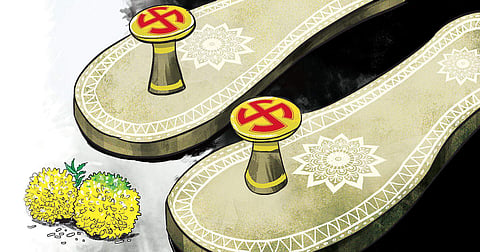

The Rigveda enumerates 33 devas or ‘shining ones’, representing primarily the forces of nature. Of these, three were important: Agni or fire, Indra or rain, and Soma, a plant. The popular deities today are two Vedic gods—Vishnu combined with a non-Vedic Narayana, and Rudra combined with a non-Vedic Shiva—and the many forms of Shakti, the supreme goddess. Agni, Indra and Soma, along with 28 others, became ‘minor deities’. Later, more minor deities were added to the Hindu pantheon: ashtadikpalas (the eight guardians of directions), navagrahas (nine planets), vasus (eight attendant deities), adityas (12 forms of the sun), rudras (11 forms of Shiva), avataras (10 incarnations of Vishnu), along with river goddesses, lesser-known forms of the main deities, village gods and goddesses and demi-gods of Buddhism and Jainism.
The original major deities of the Vedas became minor over time, while the minor deities are today among the most important deities all over India. Of the avatars, only Rama and Krishna attained cult status, while Shiva is worshipped in different forms. This is how Indian religions were made inclusive and expanded their pantheons to absorb everyone’s religious beliefs. Adi Shankara recognised six cults in his time: Vaishnava, Shaiva, Shakta, Ganapatya, Saura (Sun) and Kaumara (Kartikeya). While the six deities remain, Surya, once the ruling deity of temples in Khajuraho, Modhera, Martand and Gwalior, has been demoted to a mere navagraha.
Recently, the C P Ramaswami Aiyar Institute of Indological Research in Chennai organised a seminar on minor deities in Indian art. Scholars from various parts of India gathered to share the plurality and syncretism of Indian religious and social traditions, as represented in visual language. Religious syncretism is the blending of different belief systems, incorporating other beliefs into an existing tradition. This occurs when such traditions exist in proximity to each other and are catholic enough to accept each other’s belief systems. Hinduism, Buddhism and Jainism have made many adaptations over millenniums, assimilating elements of several religious traditions both in India and Southeast Asia.
Today’s Hinduism is a combination of different forms of beliefs and practices. It is no longer exclusively Vedic—it is the common people’s religion. Every village in India has a village deity, usually associated with fertility, rains, disease and so on. Shitala, a medicinal deity who cooled the body, became a dreaded goddess of disease in North India. Jvara, the deity of fever, who is propitiated as Jvarahareshwara in South India, is feared as the demon Jvarasura in Bengal. Mari originally meant rain and the pearl-like raindrops were called muthu-mari. Unfortunately, their resemblance to smallpox boils made Mariamman of Tamil Nadu into a dreaded goddess of disease. Thus, popular deities could change their character as social problems arose.
Village deities are generally made of terracotta, stucco or wood, and painted in brilliant colours. They may be situated in a wooden temple as in Kerala and Karnataka, or inside a simple brick-and-mortar shrine. Later, they were incorporated into exquisite stone sculpture. Each has a unique iconography. For example, Shitala in Rajasthan and Gujarat carries a broom and winnowing basket, and rides an ass. In Tamil Nadu, most village goddesses carry Durga’s weapons. But Ponni, the rice goddess, is depicted as a mere head: the earth on which the head is placed forms her body.
Folk deities may be grouped as gods of fertility, protector deities, fetishes (like stones and trees) and hero stones. The famous Ayyanaar is a protector, while goddesses protect children, combat disease and assure fertility. The popular Ayyappa of Kerala was originally a forest deity. Indian deities are associated with nature and natural resources like sacred groves and water bodies, the rain, a good harvest, disease and safety. By invoking the sanctity of rivers and lakes, animals and health, people protected the environment, controlled disease and ensured sustainable lifestyles for themselves and other creation.
What is amazing is the similarity among rural and tribal traditions across the country at a time when there was no easy communication. For example, votive offerings of terracotta horses to the deities of the sacred groves include the horses of Ayyanaar in Tamil Nadu and Bankura in Bengal. Every state shares this tradition, yet in no two states are the horses alike: that is the greatness of the Indian potter.
The minor deities were as important as the Vedic gods. A villager would never call his local goddess minor. She is all-important for him. Sometimes, the deity gets upgraded, such as Kamakshi of Kanchipuram, whose cult expanded when Rajasimha Pallava built a new temple and a new icon. Meenakshi, originally a goddess of fisherfolk, became the reigning deity of the new Pandya capital, Madurai. New mythologies were created, but old attributes were retained. They became aspects of Shakti or Vishnu or Shiva. This is how village deities were integrated into an all-Indian pantheon. The speakers at the seminar gave us a view of the many deities of their respective states, of dance forms like theyyam in Kerala and bhuta kola in Karnataka that are used to invoke gods.
No wonder it is said that there are ‘33 million deities’ in India. Yet every deity is a singular manifestation of the Supreme and the most important deity of the region. They are a reminder of a time when gods were invoked to protect people and the environment, and when religion was catholic enough to absorb other gods within an all-embracing belief system. That was syncretism, when the world was too small for more than one supreme deity, and all the gods and goddesses were merely different forms of the same Supreme Being and religious tradition.
Nanditha Krishna
Historian, environmentalist and writer based in Chennai